History of aviation

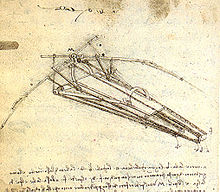
The history of aviation has extended over more than two thousand years from the earliest attempts in kites and gliders to powered heavier-than-air, supersonic, and hypersonic flight.
The first form of man-made flying objects were kites.[1] The earliest known record of kite flying is from around 200 BC in China, when a general flew a kite over enemy territory to calculate the length of tunnel required to enter the region.[2] Yuan Huangtou, a Chinese prince, survived by tying himself to the kite.[3]
Leonardo da Vinci's 15th-century dream of flight found expression in several designs, but he did not attempt to demonstrate his ideas by actually constructing them.
With the efforts to analyze the atmosphere from the 17th to 19th centuries, gases such as hydrogen were discovered which in turn led to the invention of hydrogen balloons.[1] Various theories in mechanics by physicists during the same period of time, notably fluid dynamics and Newton's laws of motion, led to the foundation of modern aerodynamics. Tethered balloons filled with hot air were used in the first half of the 19th century and saw considerable action in several mid-century wars, most notably the American Civil War, where balloons provided observation during the Battle of Petersburg.
Experiments with gliders provided the groundwork for heavier-than-air craft, and by the early 20th-century advances in engine technology and aerodynamics made controlled, powered flight possible for the first time.
Mythology
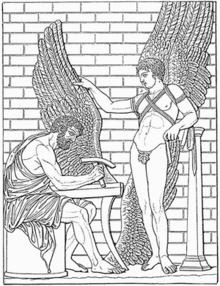
Human ambition to fly is illustrated in mythological literature of several cultures; the wings made out of wax and feathers by Daedalus in Greek mythology, or the Pushpaka Vimana of king Ravana in Ramayana, for instance.
Early attempts
Flight automaton in Greece
Around 400 BC, Archytas, the Greek philosopher, mathematician, astronomer, statesman, and strategist, designed and built a bird-shaped, apparently steam powered[4] model named "The Pigeon" (Greek: Περιστέρα "Peristera"), which is said to have flown some 200 meters.[5][6] According to Aulus Gellius, the mechanical bird was suspended on a string or pivot and was powered by a "concealed aura or spirit".[7][8]
Hot air balloons, glider and kites in China
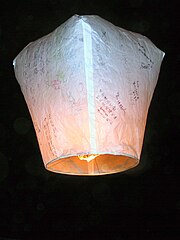
The sky lantern, an early unmanned hot air balloon, was known in China from ancient times. Its invention is usually attributed to the general Zhuge Liang (180–234 AD, honorific title Kongming), who is said to have used them to scare the enemy troops:
- An oil lamp was installed under a large paper bag, and the bag floated in the air due to the lamp heating the air. ... The enemy was frightened by the light in the air, thinking that some divine force was helping him.[9] However, the device based on a lamp in a paper shell is documented earlier, and according to Joseph Needham, hot-air balloons in China were known from the 3rd century BC.
In 1st century AD, when Wang Mang tried to recruit specialist as scout to Xiong Nu, a man binding himself with bird feather glided about 100 meters, but finally landed.[10]
Vertical flight
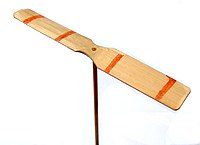
The use of a rotor for vertical flight has existed since 400 BC in the form of the bamboo-copter, an ancient Chinese toy.[11][12] The bamboo-copter is spun by rolling a stick attached to a rotor. The spinning creates lift, and the toy flies when released.[11] The philosopher Ge Hong's book the Baopuzi (Master Who Embraces Simplicity), written around 317, describes the apocryphal use of a possible rotor in aircraft: "Some have made flying cars [feiche 飛車] with wood from the inner part of the jujube tree, using ox-leather (straps) fastened to returning blades so as to set the machine in motion."[13]
Manned kite
Yuan Huangtou, Ye, first manned kite glide to take off from a tower — 559[14] During the Yuan dynasty (13th century) under rulers like Kublai Khan, the rectangular lamps became popular in festivals, when they would attract huge crowds. During the Mongol Empire, the design may have spread along the Silk Route into Central Asia and the Middle East. Almost identical floating lights with a rectangular lamp in thin paper scaffolding are common in Tibetan celebrations and in the Hindu festival of lights, Diwali. However, there is no evidence that these were used for human flight.
Gliders in Europe
In the 9th century, at the age of 65, the Muslim Andalusian polymath Abbas Ibn Firnas is said to have flown from the hill Jabal al-'arus by employing a rudimentary glider. While "alighting again on the place whence he had started," he eventually crashed and sustained injury which some contemporary critics attributed to a lack of tail.[15][16] However, the only source describing the event is from the 17th century.[17]
Between 1000 and 1010, the English Benedictine monk Eilmer of Malmesbury flew for about 200 meters using a glider (c. 1010), but he too sustained injuries.[17] The event is recorded in the work of the eminent[18] medieval historian William of Malmesbury in about 1125.[17] Being a fellow monk in the same abbey, William almost certainly obtained his account directly from people there who knew Eilmer himself.[17]
From Renaissance to the 18th century
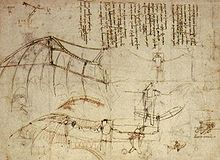

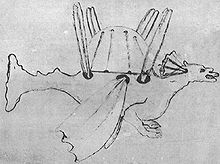
In 1488 Leonardo da Vinci's drawing depict a hang glider design in which the inner parts of the wings are fixed, and some control surfaces are provided towards the tips (as in the gliding flight in birds). While his drawings exist and are deemed flightworthy in principle, he himself never flew in it. Based on his drawings, and using materials that would have been available to him, a prototype constructed in the late 20th century was shown to fly.[19] However, his sketchy design was interpreted with modern knowledge of aerodynamic principles, and whether his actual ideas would have flown is not known. A model he built for a test flight in 1496 did not fly, and some other designs, such as the four-person screw-type helicopter, have severe flaws.
Italian inventor, Tito Livio Burattini, invited by the Polish King Władysław IV to his court in Warsaw, built a model aircraft with four fixed glider wings in 1647.[20] Described as "four pairs of wings attached to an elaborate 'dragon'", it was said to have successfully lifted a cat in 1648 but not Burattini himself.[21] He promised that "only the most minor injuries" would result from landing the craft.[22] His "Dragon Volant" is considered "the most elaborate and sophisticated aeroplane to be built before the 19th Century".[23]
In 1670 Francesco Lana de Terzi published work that suggested lighter than air flight would be possible by having copper foil spheres that contained a vacuum that would be lighter than the displaced air, lift an airship (rather literal from his drawing). While not being completely off the mark, he did fail to realize that the pressure of the surrounding air would crush the spheres.
In 1709 Bartolomeu de Gusmão presented a petition to King John V of Portugal, begging for support for his invention of an airship, in which he expressed the greatest confidence. The public test of the machine, which was set for June 24, 1709, did not take place. According to contemporary reports, however, Gusmão appears to have made several less ambitious experiments with this machine, descending from eminences. It is certain that Gusmão was working on this principle at the public exhibition he gave before the Court on August 8, 1709, in the hall of the Casa da Índia in Lisbon, when he propelled a ball to the roof by combustion.[clarification needed]
Modern flight
Lighter than air
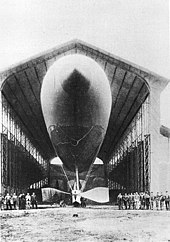
1783 was a watershed year for ballooning and aviation, between June 4 and December 1 five aviation firsts were achieved in France:
- On 4 June, the Montgolfier brothers demonstrated their unmanned hot air balloon at Annonay, France.
- On 27 August, Jacques Charles and the Robert brothers (Les Freres Robert) launched the world's first unmanned hydrogen-filled balloon, from the Champ de Mars, Paris.
- On 19 October, the Montgolfiers launched the first manned flight, a tethered balloon with humans on board, at the Folie Titon in Paris. The aviators were the scientist Jean-François Pilâtre de Rozier, the manufacture manager Jean-Baptiste Réveillon, and Giroud de Villette.
- On 21 November, the Montgolfiers launched the first free flight with human passengers. King Louis XVI had originally decreed that condemned criminals would be the first pilots, but Jean-François Pilâtre de Rozier, along with the Marquis François d'Arlandes, successfully petitioned for the honor. They drifted 8 km (5.0 mi) in a balloon powered by a wood fire.
- On 1 December, Jacques Charles and the Nicolas-Louis Robert launched their manned hydrogen balloon from the Jardin des Tuileries in Paris, amid a crowd of 400,000. They ascended to a height of about 1,800 feet (550 m)[15] and landed at sunset in Nesles-la-Vallée after a flight of 2 hours and 5 minutes, covering 36 km. After Robert alighted Charles decided to ascend alone. This time he ascended rapidly to an altitude of about 3,000 metres, where he saw the sun again, suffered extreme pain in his ears, and never flew again.

Ballooning became a major "rage" in Europe in the late 18th century, providing the first detailed understanding of the relationship between altitude and the atmosphere.
Work on developing a steerable (or dirigible) balloon (now called an airship) continued sporadically throughout the 19th century. The first powered, controlled, sustained lighter-than-air flight is believed to have taken place in 1852 when Henri Giffard flew 15 miles (24 km) in France, with a steam engine driven craft.
Non-steerable balloons were employed during the American Civil War by the Union Army Balloon Corps. The young Ferdinand von Zeppelin first flew as a balloon passenger with the Union Army of the Potomac in 1863.
Another advance was made in 1884, when the first fully controllable free-flight was made in a French Army electric-powered airship, La France, by Charles Renard and Arthur Krebs. The 170-foot (52 m) long, 66,000-cubic-foot (1,900 m3) airship covered 8 km (5.0 mi) in 23 minutes with the aid of an 8½ horsepower electric motor.
However, these aircraft were generally short-lived and extremely frail. Routine, controlled flights would not occur until the advent of the internal combustion engine (see below.)
Although airships were used in both World War I and II, and continue on a limited basis to this day, their development has been largely overshadowed by heavier-than-air craft.
Heavier than air
Supporting the aircraft

The first published paper on aviation was "Sketch of a Machine for Flying in the Air" by Emanuel Swedenborg published in 1716. This flying machine consisted of a light frame covered with strong canvas and provided with two large oars or wings moving on a horizontal axis, arranged so that the upstroke met with no resistance while the downstroke provided lifting power. Swedenborg knew that the machine would not fly, but suggested it as a start and was confident that the problem would be solved. He wrote: "It seems easier to talk of such a machine than to put it into actuality, for it requires greater force and less weight than exists in a human body. The science of mechanics might perhaps suggest a means, namely, a strong spiral spring. If these advantages and requisites are observed, perhaps in time to come some one might know how better to utilize our sketch and cause some addition to be made so as to accomplish that which we can only suggest. Yet there are sufficient proofs and examples from nature that such flights can take place without danger, although when the first trials are made you may have to pay for the experience, and not mind an arm or leg." Swedenborg would prove prescient in his observation that a method of powering of an aircraft was one of the critical problems to be overcome.
During the last years of the 18th century, Sir George Cayley started the first rigorous study of the physics of flight. In 1799 he exhibited a plan for a glider, which except for planform was completely modern in having a separate tail for control and having the pilot suspended below the center of gravity to provide stability, and flew it as a model in 1804. Over the next five decades Cayley worked on and off on the problem, during which he formulated most of basic aerodynamic theory, introducing such ideas as lift and drag. He used both internal and external combustion engines, fueled by gunpowder, in his models. Later Cayley turned his research to building a full-scale version of his design, first flying it unmanned in 1849, and in 1853 his coachman made a short unpowered gliding flight at Brompton, near Scarborough in Yorkshire.
In 1848 John Stringfellow made a successful indoor test flight of a steam-powered model, in Chard, Somerset, England.
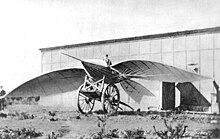
In 1856, Frenchman Jean-Marie Le Bris made the first flight higher than his point of departure, by having his glider "L'Albatros artificiel" pulled by a horse on a beach. He reportedly achieved a height of 100 meters, over a distance of 200 meters.
In 1866 Jan Wnęk a Polish peasant, sculptor and carpenter is alleged to have built and flown a controllable glider.[24] Wnęk's claims are largely based on a local oral tradition. Professor Tadeusz Seweryn, director of the Kraków Museum of Ethnography,[25] claimed to have found church records substantiating these claims, but has refused to make these available for independent scrutiny.
Francis Herbert Wenham built a series of unsuccessful unmanned gliders. He found that most of the lift from a bird-like wing appeared to be generated at the front edge, and concluded correctly that long, thin wings would be better than the bat-like ones suggested by many, because they would have more leading edge for their area. Today this relationship is known as aspect ratio of a wing. He presented a paper on his work to the newly formed Aeronautical Society of Great Britain in 1866, and decided to prove it by building the world's first wind tunnel in 1871.[26] Members of the Society used the tunnel and learned that cambered wings generated considerably more lift than expected by Cayley's Newtonian reasoning, with lift-to-drag ratios of about 5:1 at 15 degrees. This clearly demonstrated the ability to build practical heavier-than-air flying machines; what remained was the problem of controlling and powering the flight.
In 1871 the Frenchman Alphonse Pénaud successfully flew a model aircraft powered by twisted rubber in Paris. This was significant because the model had two features which gave it a degree of inherent stability: the rear-mounted tailplane was set at a smaller angle of incidence than the wings, and the wings were curved up at the tips, giving them dihedral. The principle of a difference in angle of incidence between the lifting surface and a stabilising tailplane was an original and important contribution to the theory of aeronautics.[27] The use of dihedral had been worked out by Cayley, although at the time Cayleys work was largely unknown, and Pénaud had arrived at the idea independently. Rubber powered model aircraft inspired a whole generation of future flight pioneers, including the Wright brothers who were given them as toys when children.
In 1874, Félix du Temple built the "Monoplane", a large plane made of aluminium in Brest, France, with a wingspan of 13 meters and a weight of only 80 kilograms (without the driver). Several trials were made with the plane, and it is generally recognized that it achieved lift off under its own power after a ski-jump run, glided for a short time and returned safely to the ground, making it the first successful powered flight in history, although the flight was only a short distance and a short time.

Controlling the aircraft
The 1880s became a period of intense study, characterized by the "gentleman scientists" who represented most research efforts until the 20th century. Starting in the 1880s advances were made in construction that led to the first truly practical gliders. Three people in particular were active: Otto Lilienthal, Percy Pilcher and Octave Chanute. One of the first modern gliders appears to have been built by John J. Montgomery; it flew one flight outside of San Diego on August 28, 1883. It was not until many years later that his efforts became well known. Another hang-glider had been constructed by Wilhelm Kress as early as 1877 near Vienna.
Otto Lilienthal of Germany duplicated Wenham's work and greatly expanded on it in 1874, publishing his research in 1889. He also produced a series of gliders, and starting in 1891 was able to make flights of 25 meters or more routinely. He rigorously documented his work, including photographs, and for this reason is one of the best known of the early pioneers. He also promoted the idea of "jumping before you fly", suggesting that researchers should start with gliders and work their way up, instead of simply designing a powered machine on paper and hoping it would work. His type of aircraft is now known as a hang glider.
Lilienthal died in 1896 when a gust of wind cause him to lose control: he fell from a height of roughly 50 feet (15 m) and broke his back. He died the next day. By the time of his death he had made 2500 flights of up to 250 meters using a number of designs. Lilienthal had been working on small engines suitable for powering his designs at the time of his death.
The Australian Lawrence Hargrave invented the box kite and dedicated his life to constructing flying machines. In the 1880s he experimented with monoplane models and by 1889 Hargrave had constructed a rotary airplane engine, driven by compressed air.
Picking up where Lilienthal left off, Octave Chanute took up aircraft design after an early retirement, and funded the development of several gliders. In the summer of 1896 his team flew several of their designs many times at Miller Beach, Indiana, eventually deciding that the best was a biplane design. Like Lilienthal, he documented his work and also photographed it, and was busy corresponding with like-minded researchers around the world. Chanute was particularly interested in solving the problem of aerodynamic instability of the aircraft in flight, which birds compensate for by instant corrections, but which humans would have to address either with stabilizing and control surfaces or by moving the center of gravity of the aircraft, as Lilienthal did. The most disconcerting problem was longitudinal instability (divergence), because as the angle of attack of a wing increases, the center of pressure moves forward and made the angle increase more. Without immediate correction, the craft would pitch up and stall. Much more difficult to understand was the relationship between lateral and directional control.
Powering the aircraft


Throughout this period, a number of attempts were made to produce a true powered aircraft. However the majority of these efforts were doomed to failure, being designed by ill-informed amateurs who did not have a full understanding of the problems being discussed by Lilienthal and Chanute.
In 1884, Alexander Mozhaysky's monoplane design made what is now considered to be a powered take off assisted by the use of ramp, flying between 60–100 ft (20–30 m) near Krasnoye Selo, Russia.
In France Clément Ader built the steam-powered Eole and may have made a 50-meter flight near Paris in 1890, which would be the first self-propelled "long distance" flight in history. Ader then worked on a larger design which took five years to build. In a test for the French military, the Avion III failed to fly and, caught by a gust of wind, was seriously damaged. Ader's later claims to have achieved a flight of 300 metres were later proven false. Sir Hiram Maxim made a number of experiments in Britain, eventually building an enormous 7,000 pounds (3,200 kg) machine with a wingspan of 105 feet (32 m), powered by two advanced lightweight steam engines which delivered 180 hp (134 kW) each. Maxim built it to study the basic problems of construction, lift and propulsion. He used a 1,800 feet (550 m) track with a second set of restraining rails for test runs. After a number of tests, on 31 July 1894 he started a series of runs at increasing power settings. The first two were successful, with the craft lifting off the track. In the afternoon the crew of three fired the boilers to full power, and after reaching a speed of over 42 mph (68 km/h) about 600 feet (180 m) down the track the machine produced so much lift it broke one of restraining rails and crashed after flying at a low altitudes for about 200 feet (61 m). Having spent around £30,000, and unwilling to spend more, he abandoned these experiments, only resuming his work in the 20th century, when he tested a number of smaller designs powered by gasoline engines.
Also in Britain Percy Pilcher, who had worked for Maxim and had built and successfully flown several gliders during the mid to late 1890s, constructed a prototype powered aircraft in 1899 which, recent research has shown, would have been capable of flight. However, he died in a glider accident before he was able to test it.
The "Pioneer Era" (1900–1914)
Lighter than air

The first aircraft to make routine controlled flights were non-rigid airships (later called "blimps".) The most successful early pioneering pilot of this type of aircraft was the Brazilian Alberto Santos-Dumont who effectively combined a balloon with an internal combustion engine. On October 19, 1901 he flew his airship "Number 6" over Paris from the Parc de Saint Cloud around the Eiffel Tower and back in under 30 minutes to win the Deutsch de la Meurthe prize. Santos-Dumont went on to design and build several aircraft. Subsequent controversy surrounding his and others' competing claims with regard to aircraft overshadowed his great contribution to the development of airships.
At the same time that non-rigid airships were starting to have some success, the first successful rigid airships were also being developed. These would be far more capable than fixed-wing aircraft in terms of pure cargo carrying capacity for decades. Dirigible design and advancement was pioneered by the German count Ferdinand von Zeppelin.
Construction of the first Zeppelin airship began in 1899 in a floating assembly hall on Lake Constance in the Bay of Manzell, Friedrichshafen. This was intended to ease the starting procedure, as the hall could easily be aligned with the wind. The prototype airship LZ 1 (LZ for "Luftschiff Zeppelin") had a length of 128 m (420 ft) was driven by two 10.6 kW (14.2 hp) Daimler engines and balanced by moving a weight between its two nacelles.
Its first flight, on July 2, 1900, lasted for only 18 minutes, as LZ 1 was forced to land on the lake after the winding mechanism for the balancing weight had broken. Upon repair, the technology proved its potential in subsequent flights, beating the 6 m/s velocity record of French airship La France by 3 m/s, but could not yet convince possible investors. It would be several years before the Count was able to raise enough funds for another try. Indeed, it was not until 1902 when Spanish engineer Leonardo Torres Quevedo developed his own zeppelin airship, with which he solved the serious balance problems the suspending gondola had shown in previous flight attempts[citation needed].
Heavier than air
Langley

After a distinguished career in astronomy and shortly before becoming Secretary of the Smithsonian Institution, Samuel Pierpont Langley started a serious investigation into aerodynamics at what is today the University of Pittsburgh. In 1891 he published Experiments in Aerodynamics detailing his research, and then turned to building his designs. He hoped to achieve automatic aerodynamic stability, so he gave little consideration to in-flight control.[28] On May 6, 1896, Langley's Aerodrome No. 5 made the first successful sustained flight of an unpiloted, engine-driven heavier-than-air craft of substantial size. It was launched from a spring-actuated catapult mounted on top of a houseboat on the Potomac River near Quantico, Virginia. Two flights were made that afternoon, one of 1,005 metres (3,297 ft) and a second of 700 metres (2,300 ft), at a speed of approximately 25 miles per hour (40 km/h). On both occasions the Aerodrome No. 5 landed in the water as planned, because in order to save weight, it was not equipped with landing gear. On November 28, 1896, another successful flight was made with the Aerodrome No. 6. This flight, of 1,460 metres (4,790 ft), was witnessed and photographed by Alexander Graham Bell. The Aerodrome No. 6 was actually Aerodrome No. 4 greatly modified. So little remained of the original aircraft that it was given the new designation of Aerodrome No. 6.
With the successes of the Aerodrome No. 5 and No. 6, Langley started looking for funding to build a full-scale man-carrying version of his designs. Spurred by the Spanish-American War, the U.S. government granted him $50,000 to develop a man-carrying flying machine for aerial reconnaissance. Langley planned on building a scaled-up version known as the Aerodrome A, and started with the smaller Quarter-scale Aerodrome, which flew twice on June 18, 1901, and then again with a newer and more powerful engine in 1903.
With the basic design apparently successfully tested, he then turned to the problem of a suitable engine. He contracted Stephen Balzer to build one, but was disappointed when it delivered only 8 horsepower (6 kW) instead of 12 hp (9 kW) as he expected. Langley's assistant, Charles M. Manly, then reworked the design into a five-cylinder water-cooled radial that delivered 52 horsepower (39 kW) at 950 rpm, a feat that took years to duplicate. Now with both power and a design, Langley put the two together with great hopes.
To his dismay, the resulting aircraft proved to be too fragile. Simply scaling up the original small models resulted in a design that was too weak to hold itself together. Two launches in late 1903 both ended with the Aerodrome immediately crashing into the water. The pilot, Manly, was rescued each time. As well, the aircraft's control system was inadequate to allow quick pilot responses, having no method of lateral control, and the Aerodrome's aerial stability was marginal.[28]
Langley's attempts to gain further funding failed, and his efforts ended. Nine days after his second abortive launch on December 8, the Wright brothers successfully flew their Flyer. Glenn Curtiss made 93 modifications to the Aerodrome and flew this very different aircraft in 1914.[28] Without acknowledging the modifications, the Smithsonian Institution asserted that Langley's Aerodrome was the first machine "capable of flight".[29]
Whitehead

Gustav Whitehead emigrated to America from Germany and changed his name from Gustav Weißkopf. From 1897 to 1915 he designed and built early flying machines and engines. In 1901, several years before the Wright Brothers' flight, he claimed to have carried out a controlled, powered flight in his Number 21 monoplane at Fairfield, Connecticut on 14 August 1901. The flight was reported in the Bridgeport Herald local newspaper and other eyewitness reports appeared.
In March 2013, Whitehead's flight was accepted in the editorial to the 2013 edition of Jane's All the World's Aircraft as the first powered, controlled flight of a heavier-than-air craft. [30]
The Smithsonian Institution, custodians of the original Wright Flyer, disagree that Whitehead flew as reported and maintain that the Wrights deserve the honour. [31]
The Wright brothers
Following a step by step method, discovering aerodynamic forces then controlling the flight, the brothers built and tested a series of kite and glider designs from 1900 to 1902 before attempting to build a powered design. The gliders worked, but not as well as the Wrights had expected based on the experiments and writings of their 19th-century predecessors. Their first glider, launched in 1900, had only about half the lift they anticipated. Their second glider, built the following year, performed even more poorly. Rather than giving up, the Wrights constructed their own wind tunnel and created a number of sophisticated devices to measure lift and drag on the 200 wing designs they tested.[32] As a result, the Wrights corrected earlier mistakes in calculations regarding drag and lift. Their testing and calculating produced a third glider with a larger aspect ratio and true three-axis control. They flew it successfully hundreds of times in 1902, and it performed far better than the previous models. In the end, by establishing their rigorous system of designing, wind-tunnel testing of airfoils and flight testing of full-size prototypes, the Wrights not only built a working aircraft, the Wright Flyer, but also helped advance the science of aeronautical engineering.
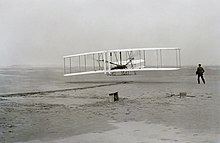
The Wrights appear to be the first design team to make serious studied attempts to simultaneously solve the power and control problems. Both problems proved difficult, but they never lost interest. They solved the control problem by inventing wing warping for roll control, combined with simultaneous yaw control with a steerable rear rudder. Almost as an afterthought, they designed and built a low-powered internal combustion engine. Relying on their wind tunnel data, they also designed and carved wooden propellers that were more efficient than any before, enabling them to gain adequate performance from their marginal engine power. Although wing-warping was used only briefly during the history of aviation, when used with a rudder it proved to be a key advance in order to control an aircraft. While many aviation pioneers appeared to leave safety largely to chance, the Wrights' design was greatly influenced by the need to teach themselves to fly without unreasonable risk to life and limb, by surviving crashes. This emphasis, as well as marginal engine power, was the reason for low flying speed and for taking off in a head wind. Performance (rather than safety) was also the reason for the rear-heavy design, because the canard could not be highly loaded; anhedral wings were less affected by crosswinds and were consistent with the low yaw stability.
According to the Smithsonian Institution and Fédération Aéronautique Internationale (FAI),[33][34] the Wrights made the first sustained, controlled, powered heavier-than-air manned flight at Kill Devil Hills, North Carolina, four miles (8 km) south of Kitty Hawk, North Carolina on December 17, 1903.
The first flight by Orville Wright, of 120 feet (37 m) in 12 seconds, was recorded in a famous photograph. In the fourth flight of the same day, Wilbur Wright flew 852 feet (260 m) in 59 seconds. The flights were witnessed by three coastal lifesaving crewmen, a local businessman, and a boy from the village, making these the first public flights and the first well-documented ones.
Orville described the final flight of the day: "The first few hundred feet were up and down, as before, but by the time three hundred feet had been covered, the machine was under much better control. The course for the next four or five hundred feet had but little undulation. However, when out about eight hundred feet the machine began pitching again, and, in one of its darts downward, struck the ground. The distance over the ground was measured to be 852 feet (260 m); the time of the flight was 59 seconds. The frame supporting the front rudder was badly broken, but the main part of the machine was not injured at all. We estimated that the machine could be put in condition for flight again in about a day or two."[35] They flew only about ten feet above the ground as a safety precaution, so they had little room to maneuver, and all four flights in the gusty winds ended in a bumpy and unintended "landing". Modern analysis by Professor Fred E. C. Culick and Henry R. Rex (1985) has demonstrated that the 1903 Wright Flyer was so unstable as to be almost unmanageable by anyone but the Wrights, who had trained themselves in the 1902 glider.[36]
The Wrights continued flying at Huffman Prairie near Dayton, Ohio in 1904–05. In May 1904 they introduced Flyer II, a heavier and improved version of the original Flyer. On June 23, 1905 they first flew a third machine Flyer III. After a severe crash on 14 July 1905, they rebuilt the Flyer III and made important design changes. They almost doubled the size of the elevator and rudder and moved them about twice the distance from the wings. They added two fixed vertical vanes (called "blinkers") between the elevators, and gave the wings a very slight dihedral. They disconnected the rudder from the wing-warping control, and as in all future aircraft, placed it on a separate control handle. When flights resumed the results were immediate. The serious pitch instability that hampered Flyers I and II was significantly reduced, so repeated minor crashes were eliminated. Flights with the redesigned Flyer III started lasting over 10 minutes, then 20, then 30. Flyer III became the first practical aircraft (though without wheels and needing a launching device), flying consistently under full control and bringing its pilot back to the starting point safely and landing without damage. On 5 October 1905, Wilbur flew 24 miles (39 km) in 39 minutes 23 seconds."[37]
According to the April 1907 issue of the Scientific American magazine,[38] the Wright brothers seemed to have the most advanced knowledge of heavier-than-air navigation at the time. However, the same magazine issue also claimed that no public flight had been made in the United States before its April 1907 issue. Hence, they devised the Scientific American Aeronautic Trophy in order to encourage the development of a heavier-than-air flying machine.
Vuia and Ellehammer
Short powered flights were performed in Europe by Traian Vuia, in France, on March 18 and August 19, 1906 when he flew 12 and 24 meters, respectively, in a fully self propelled, fixed wing aircraft, designed by him.[39][40] He was followed by Jacob Ellehammer who built a monoplane which he tested with a tether in Danemark on September 12, 1906, flying 42 meters.[41]
Alberto Santos-Dumont
On September 13, 1906, A day after Ellehammer's tethered flight and three years after the Wright Brothers flight, the Brazilian Alberto Santos-Dumont made a public flight with the flying machine designated 14-bis also known as Oiseau de proie (French for "bird of prey"), in Paris. He used a canard elevator and pronounced wing dihedral, and covered a distance of 60 m (200 ft) on the grounds of the Chateau de Bagatelle in Paris' Bois de Boulogne, before a large crowd of witnesses. This well-documented event was the first flight verified by the Aéro-Club de France of a powered heavier-than-air machine in Europe and won the Deutsch-Archdeacon Price for the first officially observed flight further than 25 meters.

On November 12, 1906, Santos-Dumont set the first world record recognized by the Federation Aeronautique Internationale by flying 220 meters in 21.5 seconds.[42][43]
Santos-Dumont made other contributions to the field of aircraft design. He added movable surfaces, the precursor to ailerons, between the wings in an effort to gain more lateral stability. Santos-Dumont's final design was the Demoiselle monoplane (Nos. 19 to 22). This aircraft was employed as Dumont's personal transportation and he willingly let others make use of his design. In 1908 Santos-Dumont started working with Adolphe Clément's Clement-Bayard company to build the Demoiselle No 19. It was the world's first series production aircraft. By 1909 it was offered with a choice of 3 engines, Clement 20 hp; Wright 4-cyl 30 hp (Clement-Bayard had the license to manufacture Wright engines); and Clement-Bayard 40 hp designed by Pierre Clerget. The Demoiselle achieved 120 km/h.[44]
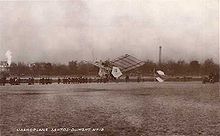
Alberto Santos-Dumont – seriously ill, and said to be depressed over his multiple sclerosis (not confirmed) and the use of aircraft in warfare – is believed to have committed suicide by hanging himself in the city of Guarujá in São Paulo, on July 23, 1932.[45]
Helicopter
In 1877, Enrico Forlanini developed an unmanned helicopter powered by a steam engine. It rose to a height of 13 meters, where it remained for some 20 seconds, after a vertical take-off from a park in Milan.
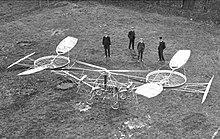
The first time a manned helicopter is known to have risen off the ground was in late September 1907 within France in a "tethered" test flight, and another French helicopter made the first rotary-winged "free flight" two months later at Lisenux, France. The first successful rotorcraft of any type, however, wasn't a true helicopter, but an autogyro invented by Spanish engineer Juan de la Cierva in 1919. These kind of rotorcraft were mainly used until the development of modern helicopters, when, for some reason, they became largely neglected, although the idea has since been resurrected several times. Since the first practical helicopter was the Focke Achgelis Fw 61 (Germany, 1936), the autogyro's golden age only lasted around 20 years.
Military use
Almost as soon as they were invented, planes were drafted for military service. The first country to use planes for military purposes was Italy, whose planes made reconnaissance, bombing and shelling correction military flights during the Italian-Turkish war (September 1911 – October 1912), in Libya. First mission (a reconnaissance) happened on 23 October 1911. First bombing of enemy columns was the 1st November 1911.[46] Then Bulgaria followed this example. Its planes attacked and reconnoitered the Ottoman positions during the First Balkan War 1912–13. The first war to see major use of planes in offensive, defensive and reconnaissance capabilities was World War I. The Allies and Central Powers both used planes extensively.
While the concept of using the airplane as a weapon of war was generally laughed at before World War I,[47] the idea of using it for photography was one that was not lost on any of the major forces. All of the major forces in Europe had light aircraft, typically derived from pre-war sporting designs, attached to their reconnaissance departments. Radiotelephones were also being explored on airplanes, notably the SCR-68, as communication between pilots and ground commander grew more and more important.
World War I (1914–1918)

Combat schemes
It was not long before aircraft were shooting at each other, but the lack of any sort of steady point for the gun was a problem. The French solved this problem when, in late 1914, Roland Garros attached a fixed machine gun to the front of his plane, but while Adolphe Pegoud would become known as the first "ace", getting credit for five victories, before also becoming the first ace to die in action, it was German Luftstreitkräfte Leutnant Kurt Wintgens, who, on July 1, 1915, scored the very first aerial victory by a purpose-built fighter plane, with a synchronized machine gun.
Aviators were styled as modern day knights, doing individual combat with their enemies. Several pilots became famous for their air to air combats, the most well known is Manfred von Richthofen, better known as the Red Baron, who shot down 80 planes in air to air combat with several different planes, the most celebrated of which was the Fokker Dr.I. On the Allied side, René Paul Fonck is credited with the most all-time victories at 75, even when later wars are considered
France, Britain, Germany and Italy were the leading manufacturers of fighter planes that saw action during the war.[48]
Technology and performance advances in aviation's "Golden Age" (1918–1939)
The years between World War I and World War II saw great advancements in aircraft technology. Airplanes evolved from low-powered biplanes made from wood and fabric to sleek, high-powered monoplanes made of aluminum, based primarily on the founding work of Hugo Junkers during the World War I period and its adoption by American designer William Bushnell Stout and Soviet designer Andrei Tupolev. The age of the great rigid airships came and went.

After World War I experienced fighter pilots were eager to show off their new skills. Many American pilots became barnstormers, flying into small towns across the country and showing off their flying abilities, as well as taking paying passengers for rides. Eventually the barnstormers grouped into more organized displays. Air shows sprang up around the country, with air races, acrobatic stunts, and feats of air superiority. The air races drove engine and airframe development—the Schneider Trophy, for example, led to a series of ever faster and sleeker monoplane designs culminating in the Supermarine S.6B. With pilots competing for cash prizes, there was an incentive to go faster. Amelia Earhart was perhaps the most famous of those on the barnstorming/air show circuit. She was also the first female pilot to achieve records such as crossing of the Atlantic and Pacific Oceans.

Other prizes, for distance and speed records, also drove development forwards. For example on June 14, 1919, Captain John Alcock and Lieutenant Arthur Brown co-piloted a Vickers Vimy non-stop from St. John's, Newfoundland to Clifden, Ireland, winning the £13,000 ($65,000)[49] Northcliffe prize. The first aerial crossing of the South Atlantic (the first using astronomical navigation only) was made by the Portuguese naval aviators Gago Coutinho and Sacadura Cabral in 1922, from Lisbon, Portugal, to Rio de Janeiro, Brazil, in an aircraft specifically fitted for himself[50] with an artificial horizon for aeronautical use, an invention that revolutionized air navigation at the time. Five years later Charles Lindbergh took the Orteig Prize of $25,000 for the first solo non-stop crossing of the Atlantic. Months after Lindbergh, Paul Redfern was the first to solo the Caribbean Sea and was last seen flying over Venezuela.
Australian Sir Charles Kingsford Smith was the first to fly across the larger Pacific Ocean in the Southern Cross. His crew left Oakland, California to make the first trans-Pacific flight to Australia in three stages. The first (from Oakland to Hawaii) was 2,400 miles, took 27 hours 25 minutes and was uneventful. They then flew to Suva, Fiji 3,100 miles away, taking 34 hours 30 minutes. This was the toughest part of the journey as they flew through a massive lightning storm near the equator. They then flew on to Brisbane in 20 hours, where they landed on 9 June 1928 after approximately 7,400 miles total flight. On arrival, Kingsford Smith was met by a huge crowd of 25,000 at Eagle Farm Airport in his hometown of Brisbane. Accompanying him were Australian aviator Charles Ulm as the relief pilot, and the Americans James Warner and Captain Harry Lyon (who were the radio operator, navigator and engineer). A week after they landed, Kingsford Smith and Ulm recorded a disc for Columbia talking about their trip. With Ulm, Kingsford Smith later continued his journey being the first in 1929 to circumnavigate the world, crossing the equator twice.
The first lighter-than-air crossings of the Atlantic were made by airship in July 1919 by His Majesty's Airship R34 and crew when they flew from East Lothian, Scotland to Long Island, New York and then back to Pulham, England. By 1929, airship technology had advanced to the point that the first round-the-world flight was completed by the Graf Zeppelin in September and in October, the same aircraft inaugurated the first commercial transatlantic service. However the age of the dirigible ended following the destruction by fire of the zeppelin Hindenburg just before landing at Lakehurst, New Jersey on May 6, 1937, killing 35 of the 97 people aboard. Previous spectacular airship accidents, from the Wingfoot Express disaster (1919) to the loss of the R101 (1930), the Akron (1933) and the Macon (1935) had already cast doubt on airship safety; following the destruction of the Hindenburg, the remaining airship making international flights, the Graf Zeppelin was retired (June 1937). Its replacement, the dirigible Graf Zeppelin II, made a number of flights, primarily over Germany, from 1938 to 1939, but was grounded when Germany began World War II. Both remaining German zeppelins were scrapped in 1940 to supply metal for the German Luftwaffe; the last American airship, the Los Angeles, which had not flown since 1932, was dismantled in late 1939.
Meanwhile in Germany, which was restricted by the Treaty of Versailles in its development of powered aircraft, instead developed gliding as a sport, especially at the Wasserkuppe, during the 1920s. In its various forms, this activity now has over 400,000 participants.[51][52]
In 1929 Jimmy Doolittle developed instrument flight.
1929 also saw the first flight of by far the largest plane ever built until then: the Dornier Do X with a wing span of 48 m. On its 70th test flight on October 21 there were 169 people on board, a record that was not broken for 20 years.
Less than a decade after the development of the first practical rotorcraft of any type with the autogyro, in the Soviet Union, Boris N. Yuriev and Alexei M. Cheremukhin, two aeronautical engineers working at the Tsentralniy Aerogidrodinamicheskiy Institut (TsAGI, Russian: Центра́льный аэрогидродинами́ческий институ́т (ЦАГИ), English: Central Aerohydrodynamic Institute), constructed and flew the TsAGI 1-EA single rotor helicopter, which used an open tubing framework, a four blade main rotor, and twin sets of 1.8-meter (6-foot) diameter anti-torque rotors; one set of two at the nose and one set of two at the tail. Powered by two M-2 powerplants, up-rated copies of the Gnome Monosoupape rotary radial engine of World War I, the TsAGI 1-EA made several successful low altitude flights. By 14 August 1932, Cheremukhin managed to get the 1-EA up to an unofficial altitude of 605 meters (1,985 ft) with what is likely to be the first successful single-lift rotor helicopter design ever tested and flown.
Only five years after the German Dornier Do-X had flown, Tupolev designed the largest aircraft of the 1930s era, the Maksim Gorky in the Soviet Union by 1934, as the largest aircraft ever built using the Junkers methods of metal aircraft construction.
In the 1930s development of the jet engine began in Germany and in Britain - both countries would go on to develop jet aircraft by the end of World War II.
Progress goes on and massive production, World War II (1939–1945)
World War II saw a drastic increase in the pace of aircraft development and production. All countries involved in the war stepped up development and production of aircraft and flight based weapon delivery systems, such as the first long range bomber. Also air combat tactics and doctrines changed, large scale strategic bombing campaigns were launched, fighter escorts introduced and the more flexible aircraft and weapons allowed precise attacks on small targets with dive bombers, fighter-bombers, and ground-attack aircraft. New technologies like radar also allowed more coordinated and controlled deployment of air defense.

The first functional jetplane was the Heinkel He 178 (Germany), flown by Erich Warsitz in 1939, followed by the world's first operational jet aircraft, the Me 262, in July 1942 and world's first jet-powered bomber, the Arado Ar 234, in June 1943. British developments, like the Gloster Meteor, followed afterwards, but saw only brief use in World War II. The first cruise missile (V-1), the first ballistic missile (V-2), the first (and to date only) operational rocket-powered combat aircraft Me 163 and the first vertical take-off manned point-defense interceptor Bachem Ba 349 were also developed by Germany. However, jet fighters had only limited impact due to their late introduction, fuel shortages, the lack of experienced pilots and the declining war industry of Germany.
Not only airplanes, but also helicopters saw rapid development in the Second World War. With the introduction of the Focke Achgelis Fa 223, the Flettner Fl 282 in 1941 in Germany and the Sikorsky R-4 in 1942 in the USA, for the first time larger helicopter formations were produced and deployed.
1945–1991: The Cold War
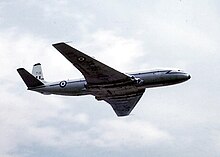
After World War II, commercial aviation grew rapidly, using mostly ex-military aircraft to transport people and cargo. This growth was accelerated by the glut of heavy and super-heavy bomber airframes like the B-29 and Lancaster that could be converted into commercial aircraft. The DC-3 also made for easier and longer commercial flights. The first commercial jet airliner to fly was the British de Havilland Comet. By 1952, the British state airline BOAC had introduced the Comet into scheduled service. While a technical achievement, the plane suffered a series of highly public failures, as the shape of the windows led to cracks due to metal fatigue. The fatigue was caused by cycles of pressurization and depressurization of the cabin, and eventually led to catastrophic failure of the plane's fuselage. By the time the problems were overcome, other jet airliner designs had already taken to the skies.
USSR's Aeroflot became the first airline in the world to operate sustained regular jet services on September 15, 1956 with the Tupolev Tu-104. The Boeing 707 and DC-8 which established new levels of comfort, safety and passenger expectations, ushered in the age of mass commercial air travel, dubbed the Jet Age.
In October 1947 Chuck Yeager took the rocket-powered Bell X-1 through the sound barrier. Although anecdotal evidence exists that some fighter pilots may have done so while dive bombing ground targets during the war[citation needed], this was the first controlled, level flight to exceed the speed of sound. Further barriers of distance fell in 1948 and 1952 with the first jet crossing of the Atlantic and the first nonstop flight to Australia.
The 1945 invention of nuclear bombs briefly increased the strategic importance of military aircraft in the Cold War between East and West. Even a moderate fleet of long-range bombers could deliver a deadly blow to the enemy, so great efforts were made to develop countermeasures. At first, the supersonic interceptor aircraft were produced in considerable numbers. By 1955 most development efforts shifted to guided surface-to-air missiles. However, the approach diametrically changed when a new type of nuclear-carrying platform appeared that could not be stopped in any feasible way: intercontinental ballistic missiles. The possibility of these was demonstrated in 1957 with the launch of Sputnik 1 by the Soviet Union. This action started the Space Race between the nations.
In 1961, the sky was no longer the limit for manned flight, as Yuri Gagarin orbited once around the planet within 108 minutes, and then used the descent module of Vostok I to safely reenter the atmosphere and reduce speed from Mach 25 using friction and converting velocity into heat. The United States responded by launching Alan Shepard into space on a suborbital flight in a Mercury space capsule. With the launch of the Alouette I in 1963, Canada became the third country to send a satellite in space. The space race between the United States and the Soviet Union would ultimately lead to the landing of men on the moon in 1969.
In 1967, the X-15 set the air speed record for an aircraft at 4,534 mph (7,297 km/h) or Mach 6.1 (7,297 km/h). Aside from vehicles designed to fly in outer space, this record was renewed by X-43 in the 21st century.

The Harrier Jump Jet, often referred to as just "Harrier" or "the Jump Jet", is a British designed military jet aircraft capable of Vertical/Short Takeoff and Landing (V/STOL) via thrust vectoring. It first flew in 1969. The same year that Neil Armstrong and Buzz Aldrin set foot on the moon, and Boeing unveiled the Boeing 747 and the Aérospatiale-BAC Concorde supersonic passenger airliner had its maiden flight. The Boeing 747 was the largest commercial passenger aircraft ever to fly, and still carries millions of passengers each year, though it has been superseded by the Airbus A380, which is capable of carrying up to 853 passengers. In 1975 Aeroflot started regular service on the Tu-144—the first supersonic passenger plane. In 1976 British Airways and Air France began supersonic service across the Atlantic, with Concorde. A few years earlier the SR-71 Blackbird had set the record for crossing the Atlantic in under 2 hours, and Concorde followed in its footsteps.
The last quarter of the 20th century saw a slowing of the pace of advancement. No longer was revolutionary progress made in flight speeds, distances and technology. This part of the century saw the steady improvement of flight avionics, and a few minor milestones in flight progress.
For example, in 1979 the Gossamer Albatross became the first human powered aircraft to cross the English channel. This achievement finally saw the realization of centuries of dreams of human flight. In 1981, the Space Shuttle made its first orbital flight, proving that a large rocket ship can take off into space, provide a pressurised life support system for several days, reenter the atmosphere at orbital speed, precision glide to a runway and land like a plane.
In 1986 Dick Rutan and Jeana Yeager flew an aircraft, the Rutan Voyager, around the world unrefuelled, and without landing. In 1999 Bertrand Piccard became the first person to circle the earth in a balloon. Focus was turning to the ultimate conquest of space and flight at faster than the speed of sound. The ANSARI X PRIZE inspired entrepreneurs and space enthusiasts to build their own rocket ships to fly faster than sound and climb into the lower reaches of space.
2001–present

In commercial aviation, the early 21st century saw the end of an era with the retirement of Concorde. Only commercially viable in niche markets, the planes were required to fly over the oceans if they wanted to break the sound barrier. Concorde was fuel hungry and could carry a limited amount of passengers due to its highly streamlined design. Nevertheless, it seems to have made a significant operating profit for British Airways.
In the beginning of the 21st century, subsonic military aviation focused on eliminating the pilot in favor of remotely operated or completely autonomous vehicles. Several unmanned aerial vehicles or UAVs have been developed. In April 2001 the unmanned aircraft Global Hawk flew from Edwards AFB in the US to Australia non-stop and unrefuelled. This is the longest point-to-point flight ever undertaken by an unmanned aircraft, and took 23 hours and 23 minutes. In October 2003 the first totally autonomous flight across the Atlantic by a computer-controlled model aircraft occurred.
The U.S. Centennial of Flight Commission was established in 1999 to encourage the broadest national and international participation in the celebration of 100 years of powered flight.[53] It publicized and encouraged a number of programs, projects and events intended to educate people about the history of aviation.
Major disruptions to air travel in the 21st century included the closing of U.S. airspace due to the September 11 attacks, and the closing of most of European airspace after the 2010 eruption of Eyjafjallajökull.
See also
- Aviation archaeology
- Early flying machines
- Timeline of aviation
- List of firsts in aviation
- Maiden flight dates
References
- ^ a b Crouch, Tom (2004), Wings: A History of Aviation from Kites to the Space Age, New York, New York: W.W. Norton & Co, ISBN 0-393-32620-9
- ^ Brown, Brian (1922), Chinese Nights Entertainments, Brentano's, OCLC 843525
- ^ Needham, Joseph; Ronan, Colin A (1994), The Shorter Science and Civilisation in China: An Abridgement of Joseph Needham's Original Text, vol. 4, part 2, Cambridge University Press, p. 285, ISBN [[Special:BookSources/0-521-32955-7 (Hardback)|0-521-32955-7[[Category:Articles with invalid ISBNs]] (Hardback)]], retrieved 2010-10-11
{{citation}}: Check|isbn=value: invalid character (help); Unknown parameter|part=ignored (help) - ^ Darling, David J. (2003), The Complete Book of Spaceflight: From Apollo 1 to zero Gravity, New York, New York: John Wiley and Sons, ISBN 0-471-05649-9, retrieved 2010-09-13
- ^ Gellius, Aulus (1795), The Attic nights of Aulus Gellius, J. Johnson
{{citation}}: Unknown parameter|coauthors=ignored (|author=suggested) (help) - ^ Archytas of Tarentum, Technology Museum of Thessaloniki, Macedonia, Greece, retrieved 2009-06-27
- ^ Howe, Henry (1858), Memoirs of the most eminent American mechanics, New York, New York: Derby & Jackson, retrieved 2010-09-13
- ^ Wise, John (1850), A System of Aeronautics, Comprehending its Earliest Investigations, and Modern Practice and Art, Philadelphia, PA: Joseph A Speel, retrieved 2010-09-13
- ^ Deng, Yinke; Wang, Pingxing (2005), Ancient Chinese Inventions, China Intercontinental Press, p. 113, ISBN 7-5085-0837-8, retrieved 2010-09-13
- ^ Book of Han, Biography of Wang Mang, 或言能飞,一日千里,可窥匈奴。莽辄试之,取大鸟翮为两翼,头与身皆著毛,通引环纽,飞数百步堕
- ^ a b Leishman, J. Gordon. Principles of Helicopter Aerodynamics. Cambridge aerospace series, 18. Cambridge: Cambridge University Press, 2006. ISBN 978-0-521-85860-1. pp. 7-9. Web extract
- ^ Topher Donahue (15 January 2009). Bugaboo Dreams: A Story of Skiers, Helicopters and Mountains. Rocky Mountain Books Ltd. p. 249. ISBN 978-1-897522-11-0.
- ^ Joseph Needham (1965), Science and civilisation in China: Physics and physical technology, mechanical engineering Volume 4, Part 2, page 583-587.
- ^ (永定三年)使元黄头与诸囚自金凤台各乘纸鸱以飞,黄头独能至紫陌乃堕,仍付御史中丞毕义云饿杀之。(Rendering: [In the 3rd year of Yongding, 559], Gao Yang conducted an experiment by having Yuan Huangtou and a few prisoners launch themselves from a tower in Ye, capital of the Northern Qi. Yuan Huangtou was the only one who survived from this flight, as he glided over the city-wall and fell at Zimo [western segment of Ye] safely, but he was later executed.) Zizhi Tongjian 167.
- ^ Lynn Townsend White, Jr. (Spring, 1961). "Eilmer of Malmesbury, an Eleventh Century Aviator: A Case Study of Technological Innovation, Its Context and Tradition", Technology and Culture 2 (2), p. 97–111 [100–101].
- ^ "First Flights", Saudi Aramco World, 15 (1): 8–9, January/February 1964, retrieved 2010-09-13.
{{citation}}: Check date values in:|date=(help) - ^ a b c d Lynn Townsend White, Jr. (Spring, 1961). "Eilmer of Malmesbury, an Eleventh Century Aviator: A Case Study of Technological Innovation, Its Context and Tradition", Technology and Culture 2 (2), p. 97-111 [100f.] Cite error: The named reference "Lynn White 1961, 100f." was defined multiple times with different content (see the help page).
- ^ White 1961, p. 98
- ^ Dreams of Leonardo, program by Public Broadcasting Service (PBS), October 2005, describes the building and successful flight of a glider based on Leonardo's design
- ^ Needham, Joseph (1965). Science and Civilisation in China. Vol. IV (part 2). p. 591. ISBN 978-0-521-05803-2.
- ^ Harrison, James Pinckney (2000). Mastering the Sky. Da Capo Press. p. 27. ISBN 978-1-885119-68-1.
- ^ Qtd. in O'Conner, Patricia T. (1985-11-17). "In Short: Nonfiction; Man Was Meant to Fly, But Not at First". The New York Times. Retrieved 2009-05-24.
- ^ ["Burattini's Flying Dragon", FLIGHT International, 9 May 1963 | http://www.flightglobal.com/pdfarchive/view/1963/1963%20-%200722.html]
- ^ Kulawik, Piotr. "Jan Wnęk l'héros de sous la voûte de ciel" (in French). Retrieved 2010-09-13.
{{cite web}}: Unknown parameter|trans_title=ignored (|trans-title=suggested) (help) - ^ "The Biggest Museums in Krakow". Krakow-info.com. 2010-09-03. Retrieved 2011-12-30.
- ^ Frank H. Wenham, inventor of the wind tunnel, 1871, was a fan, driven by a steam engine, propelled air down a 12 ft (3.7 m). (3.7 m) tube to the model. NASA: [1]
- ^ Gibbs-Smith, Charles H. (2000). Aviation. London: NMSI. p. 56. ISBN [[Special:BookSources/19000747529|19000747529[[Category:Articles with invalid ISBNs]]]].
{{cite book}}: Check|isbn=value: invalid character (help) - ^ a b c Anderson, John David (2004). Inventing Flight: The Wright Brothers & Their Predecessors. JHU Press. p. 145. ISBN 0801868750.
- ^ Hallion, Richard P. (2003). Taking Flight:Inventing the Aerial Age, from Antiquity through the First World War. Oxford University Press. pp. 294–295. ISBN 0195160355.
- ^ Paul Jackson; Executive Overview: Jane's All the World's Aircraft: Development & Production - 'Justice delayed is justice denied' (2013)
- ^ Budd Davisson; Who Was First? The Wrights or Whitehead? Flight Journal (2013)
- ^ Dodson, MG (2005), "An Historical and Applied Aerodynamic Study of the Wright Brothers' Wind Tunnel Test Program and Application to Successful Manned Flight", US Naval Academy Technical Report, USNA-334, retrieved 2009-03-11
- ^ Smithsonian Institution, "The Wright Brothers & The Invention of the Aerial Age"
- ^ " 100 Years Ago, the Dream of Icarus Became Reality." FAI NEWS, December 17, 2003. Retrieved: January 5, 2007.
- ^ Kelly, Fred C. The Wright Brothers: A Biography Chp. IV, p.101–102 (Dover Publications, NY 1943).
- ^ Abzug, Malcolm J. and E. Eugene Larrabee."Airplane Stability and Control, Second Edition: A History of the Technologies That Made Aviation Possible." cambridge.org. Retrieved: September 21, 2010.
- ^ Dayton Metro Library Aero Club of America press release
- ^ Reprinted in Scientific American, April 2007, page 8.
- ^ "Nouveaux essais de l'Aéroplane Vuia", L'Aérophile v.14 1906, p. 105-106, April 1906
- ^ "L'Aéroplane à moteur de M. Vuia", L'Aérophile v.14 1906, p. 195-196, September 1906
- ^ Jacob Ellehammer at EarlyAviators.com. Retrieved March 7, 2013.
- ^ Jines. Ernest. "Santos Dumont in France 1906-1916: The Very Earliest Early Birds." earlyaviators.com, December 25, 2006. Retrieved: August 17, 2009.
- ^ "Cronologia de Santos Dumont" (in Portuguese). santos-dumont.net.Retrieved: October 12, 2010.
- ^ Hartmann, Gérard. "Clément-Bayard, sans peur et sans reproche" (French). hydroretro.net. Retrieved: November 14, 2010.
- ^ "Alberto Santos Dumont Lies In State in Brazil's Capital." New York Times, December 19, 1932.
- ^ Ferdinando Pedriali. "Aerei italiani in Libia (1911–1912)"(Italian planes in Libya (1911–1912)). Storia Militare (Military History), N° 170/novembre 2007,p.31–40
- ^ with the exception of Clément Ader, who had visionary views about that : "L'affaire de l'aviation militaire" (Military aviation concern), 1898 and "La première étape de l'aviation militaire en France" (The first step of military aviation en France), 1906
- ^ WWI airplane statistics by nation
- ^ Nevin, David. "Two Daring Flyers Beat the Atlantic before Lindbergh." Journal of Contemporary History' 28: (1) 1993, 105.
- ^ CAMBESES JÚNIOR, Manuel, A Primeira Travessia Aérea do Atlântico Sul, Brasília: INCAER, 2008.
- ^ FAI membership summary, retrieved 2006-08-24
- ^ FAI web site
- ^ Executive Summary, U.S. Centennial of Flight Commission
Further reading
- Celebrating a History of Flight, NASA Office of Aerospace Technology HQ, United States Air Force
- Harry Bruno (1944) Wings over America: The Story of American Aviation, Halcyon House, Garden City, New York.
- Jourdain, Pierre-Roger (1908), "Aviation In Frances In 1908", Annual Report of the Board of Regents of the Smithsonian Institution: 145–159, retrieved 2009-08-07
{{citation}}: Cite has empty unknown parameters:|month=and|coauthors=(help) - Post, Augustus (1910), "How To Learn To Fly: The Different Machines And What They Cost", The World's Work: A History of Our Time, XX: 13389–13402, retrieved 2009-07-10
{{citation}}: Cite has empty unknown parameter:|coauthors=(help); Unknown parameter|month=ignored (help) Includes photos, diagrams and specifications of many c. 1910 aircraft. - Squier, George Owen (1908), "The Present Status of Military Aeronautics", Annual Report of the Board of Regents of the Smithsonian Institution: 117–144, retrieved 2009-08-07
{{citation}}: Cite has empty unknown parameters:|month=and|coauthors=(help) Includes photos and specifics of many c. 1908 dirigibles and airplanes.
External links
- http://www.flyingmachines.org/
- http://www.thewrightbrothers.org/fivefirstflights.html
- Time line of greatest breakthroughs in manned flight by Jürgen Schmidhuber, Nature 421, 689, 2003
- Prehistory of Flight
- Graphic time-line
- University of Washington Libraries Digital Collections—Transportation Photographs An ongoing digital collection of photographs depicting various modes of transportation in the Pacific Northwest region and Western United States during the first half of the 20th century.
- Aviation research at the National Archives—how to find aviation photos and records.
- Aviation: From Sand Dunes to Sonic Booms, a National Park Service Discover Our Shared Heritage Travel Itinerary
- Aviation history article.
- Aviation History at Muswell Manor
- Film trailer of A Dream of Flight a documentary that celebrates the centenary of the first powered flight by a Briton in Britain, JTC Moore Brabazon, in 1909 on The Isle of Sheppey.
- Wright Brothers' Early Flight Experiments
- See pictures of strut design airplanes from 1911 at the University of Houston Digital Library
